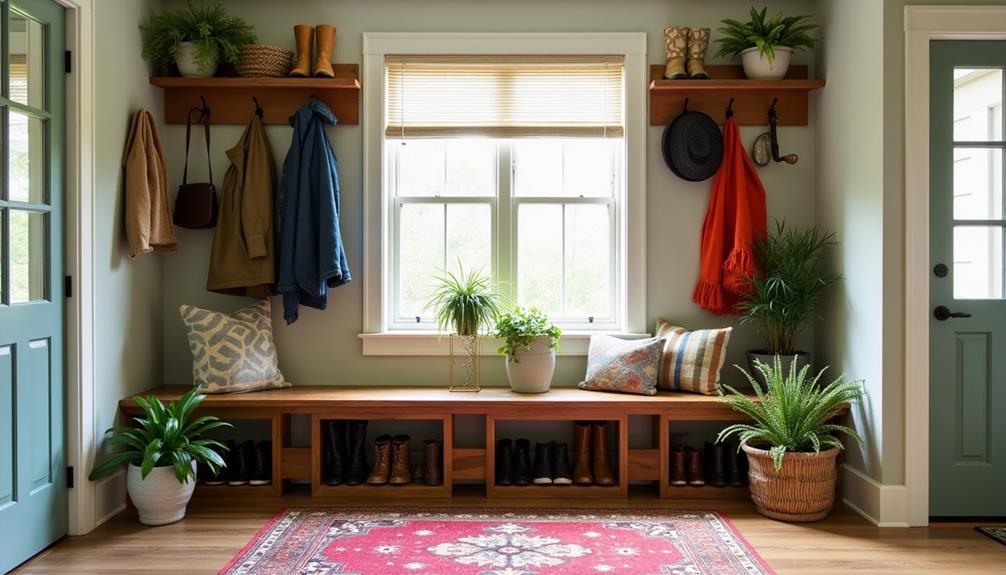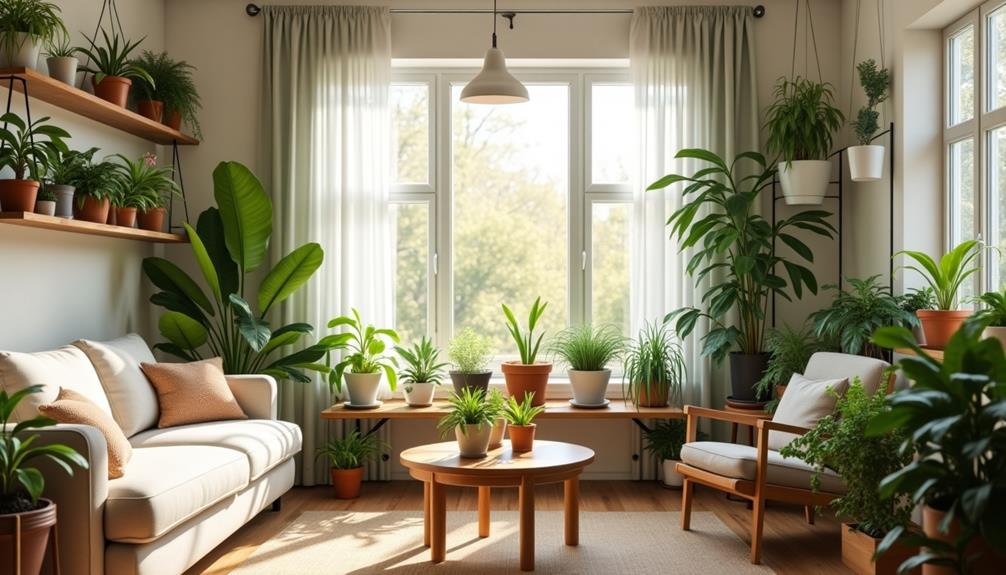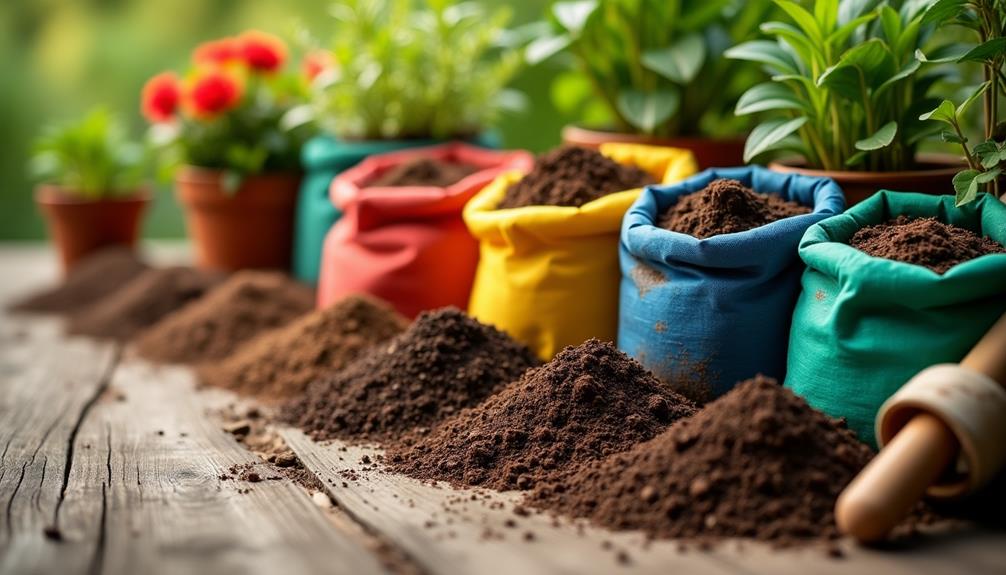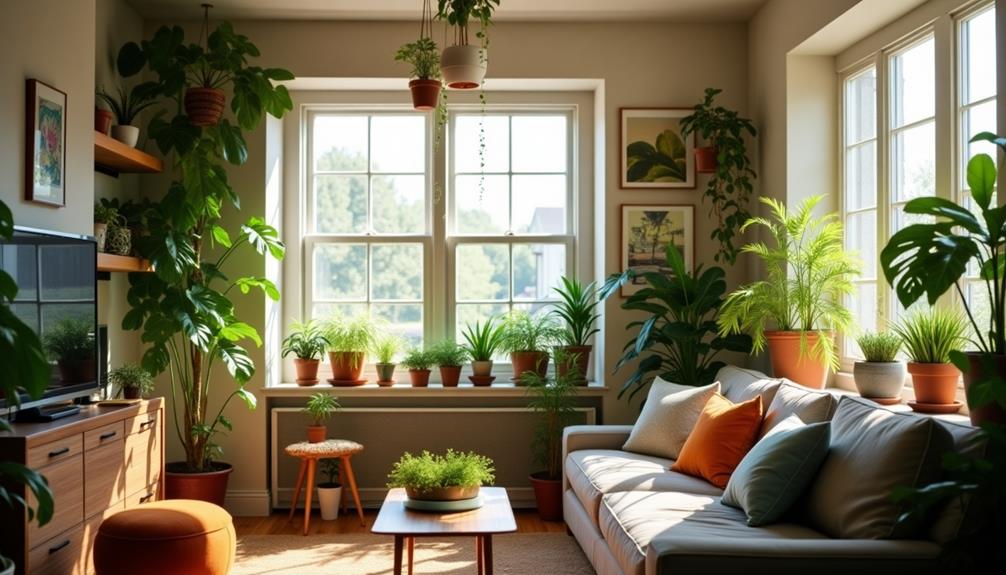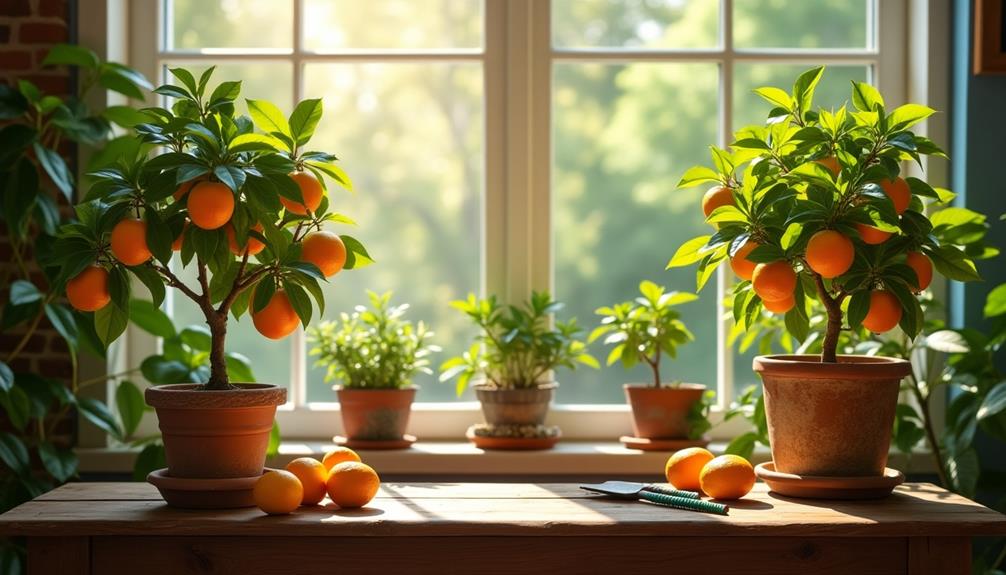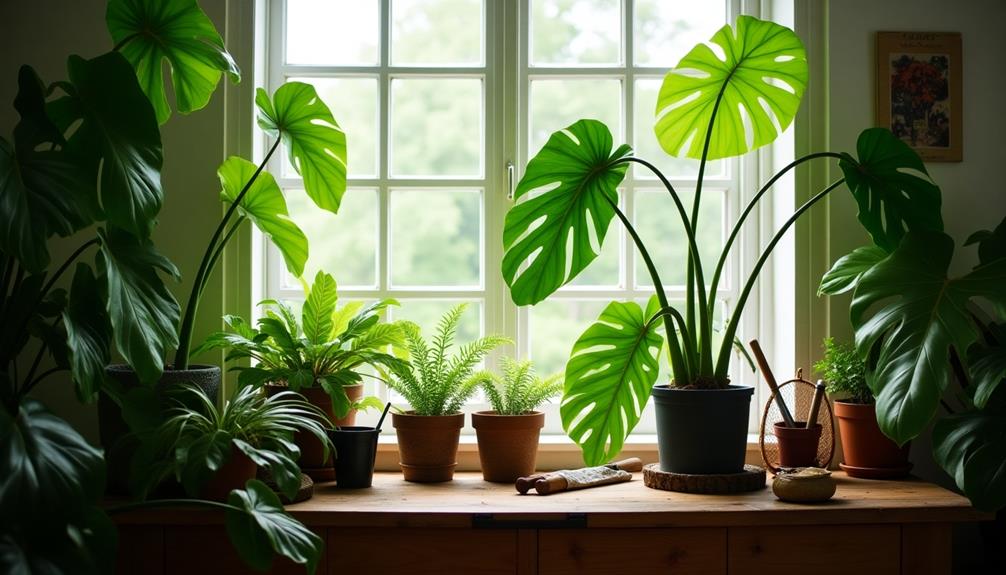You might think you don't have enough space for a mudroom, but even a small entryway can be transformed into a functional area. By strategically assessing your available space and choosing the right elements, you can create a practical setup that meets your family's needs. Consider how smart storage solutions and designated zones can enhance organization and efficiency, yet there's more to it than just storage. Discover how personalization and maintenance can elevate your mudroom from merely functional to truly inviting.
Assess Your Space
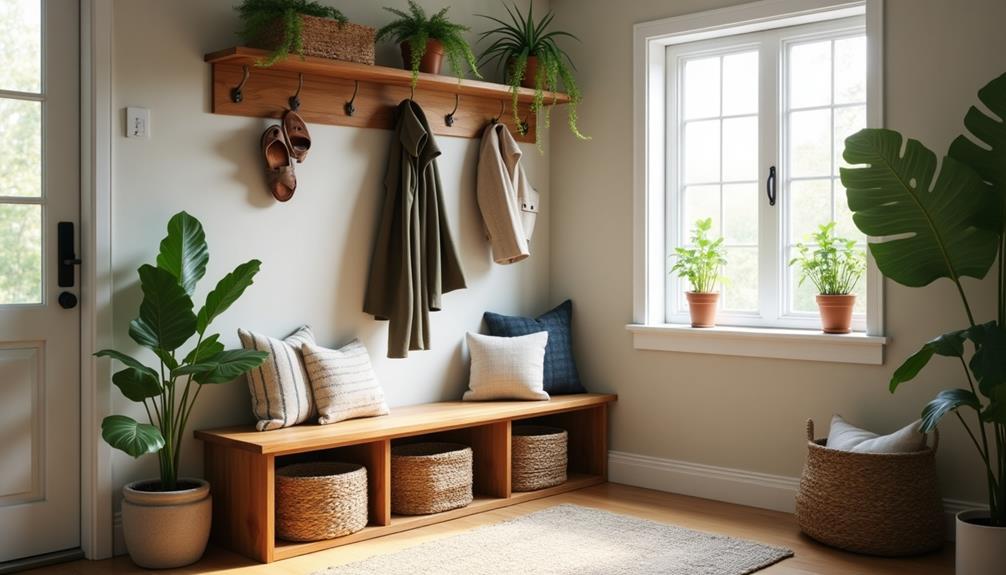
Before diving into your mudroom setup, take a good look at the space you have. Assessing the space dimensions is crucial for creating a functional environment. Measure the length, width, and height of your mudroom to understand how much room you're working with. This'll help you determine what elements can fit without overcrowding the area.
Next, consider your lighting options. A well-lit mudroom not only enhances functionality but also creates a welcoming atmosphere. If natural light is limited, think about installing bright overhead lights or wall sconces that provide ample illumination.
You might even want to incorporate task lighting near specific areas, like a bench or storage compartments, to ensure everything's visible when you need it.
Don't forget to account for the flow of traffic in your mudroom. Ensure that doors and pathways are unobstructed, allowing easy access in and out of the space.
Choose the Right Furniture
Selecting the right furniture for your mudroom is essential for both style and functionality. Start by considering various furniture styles that match your home's aesthetic while meeting your practical needs. From modern benches to rustic hooks, the options are endless.
Next, think about space efficiency. A well-organized mudroom helps keep your home tidy and ensures that everything has its place. Choose multi-functional pieces, such as a storage bench that provides seating and hides away shoes or bags. This way, you maximize your space while adding a stylish touch.
Don't forget about vertical storage! Wall-mounted shelves and hooks can help clear floor space, making your mudroom feel larger and more inviting.
Look for furniture that offers additional storage, like cabinets or baskets, to accommodate seasonal items and outdoor gear.
Opt for Durable Flooring
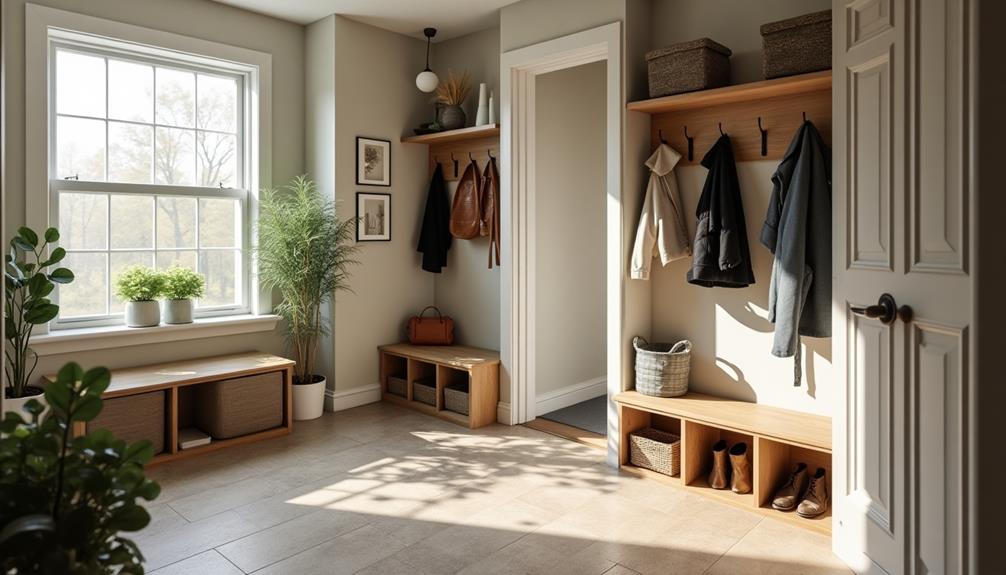
When it comes to mudroom design, you can't overlook the importance of durable flooring. The flooring you choose will endure heavy foot traffic, dirt, and moisture, so it needs to withstand daily wear and tear.
Tile options, like ceramic or porcelain, are popular choices because they're water-resistant and easy to clean. Plus, they come in various styles, allowing you to personalize your mudroom while ensuring functionality.
If you're looking for a warmer feel, consider laminate choices. These mimic the look of wood but offer increased durability against scratches and stains. Laminate is also relatively easy to install and maintain, making it a practical option for busy households.
When selecting your flooring, think about the color and texture that will complement your mudroom's overall design. Darker colors can hide dirt better, while lighter shades can make the space feel more open and inviting.
Implement Smart Storage Solutions
With durable flooring in place, it's time to focus on smart storage solutions that maximize your mudroom's functionality. One of the best ways to create space is by incorporating vertical storage solutions. Think about adding shelves or cabinets that reach up to the ceiling, allowing you to store seasonal items or less frequently used gear without cluttering the floor.
Next, consider using multi-purpose furniture. A bench with built-in storage can provide a place to sit while also holding shoes, bags, and other essentials. Look for hooks or pegs above the bench to hang coats and bags, keeping everything organized and easily accessible.
You can also use baskets or bins on the shelves for smaller items, ensuring that everything has a designated spot. Labeling these containers can further streamline your organization, making it easy to find what you need.
Designate Zones for Functionality
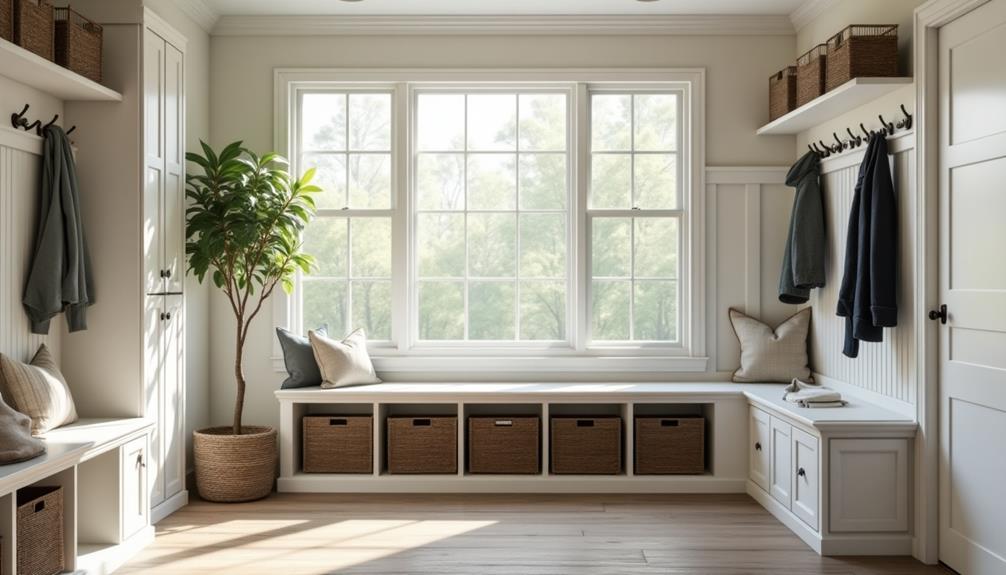
Creating designated zones in your mudroom enhances its functionality and keeps everything organized. By clearly defining areas for specific activities, you'll improve traffic flow and create multifunctional spaces that serve your family's needs.
Start by assessing how your family uses the mudroom. For example, you might designate a shoe area with a mat to catch dirt, making it easier to clean and maintain.
Next, consider a storage zone for bags, sports equipment, or pet supplies. Use bins or shelves to keep these items neatly tucked away but easily accessible.
If possible, create a small seating area for putting on or removing shoes. This can also be a space where kids can pause and drop their belongings without cluttering the entire room.
Incorporate Hooks and Racks
To maximize space and keep your mudroom organized, incorporating hooks and racks is essential. You want to make the most of vertical space, and adding decorative hooks can be a stylish and functional solution. Place them at varying heights to accommodate everyone in your family, from kids to adults. This way, everyone can easily hang their coats, bags, and hats without cluttering the floor.
Wall mounted racks are another great option for increasing storage while keeping items accessible. Consider installing a rack for shoes, which helps contain dirt and mud while providing a designated spot for footwear. You can also use wall mounted racks for additional storage, allowing you to display decorative items or practical tools like umbrellas and dog leashes.
Don't forget to personalize your hooks and racks! Choose designs that match your mudroom's aesthetic, adding personality while remaining practical.
Use Baskets for Organization
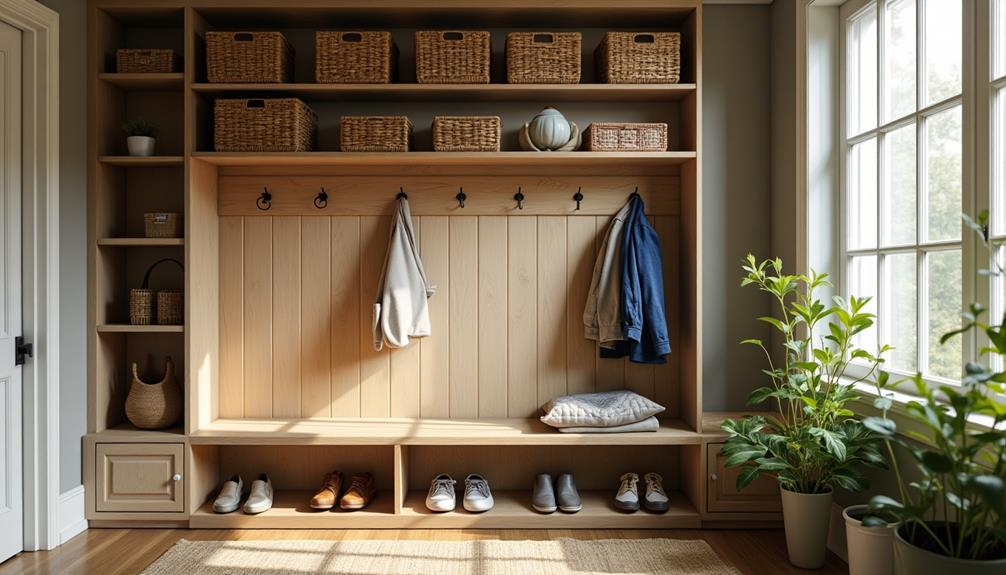
Baskets are a fantastic way to keep your mudroom organized and clutter-free.
You can choose from various types, like woven or plastic, to suit your style and needs.
Don't forget to label each basket for easy access and clarity!
Types of Baskets
Utilizing various types of baskets can transform your mudroom into an organized haven. Start by considering different basket materials like wicker, fabric, or plastic. Wicker baskets add a rustic charm, while fabric ones offer flexibility and can be easily washed. Plastic baskets are durable and come in vibrant colors, making them perfect for a more modern look.
Next, focus on basket sizes. You'll want a mix of small, medium, and large baskets to accommodate various items. Small baskets work well for keys, hand sanitizer, or dog leashes, while medium baskets can hold gloves, hats, and scarves. Large baskets are ideal for bulky items like shoes or sports equipment.
Additionally, consider how you plan to use each basket. If you often grab items on the go, choose baskets with handles for easy transport. If you're looking to store items out of sight, opt for lidded or covered baskets.
Labeling for Clarity
Once you've selected a variety of baskets for your mudroom, labeling them can significantly enhance organization and efficiency. Clear labels help everyone know where to find items and where to put them back, reducing clutter.
Consider different label types, such as tags, stickers, or chalkboard labels. Tags are great for a polished look, while chalkboard labels allow for easy updates as your needs change.
Color coding can also be a powerful organizational tool. By assigning specific colors to different categories—like blue for sports gear, red for seasonal items, and green for cleaning supplies—you make it easy for everyone to quickly identify where things belong. This visual cue helps maintain order and ensures that family members can pitch in without confusion.
When labeling, keep it simple and concise. Use clear, legible fonts and avoid overly detailed descriptions. Remember, the goal is clarity, so anyone can easily understand the system you've set up.
With a little time invested in labeling, your mudroom will transform into a functional space that supports your family's lifestyle.
Add a Bench for Convenience
Incorporating a bench into your mudroom can significantly enhance its functionality and comfort. A bench provides a convenient spot for you to sit while putting on or taking off shoes, making it easier to manage your busy lifestyle.
When selecting a bench, consider various bench styles that suit your space—like a storage bench for extra storage or a sleek, modern design for a contemporary look.
To elevate comfort, explore cushion options that complement your decor and offer a cozy seating experience. Opt for removable and washable cushion covers to keep your bench looking fresh and clean, especially in a high-traffic area like the mudroom.
Position the bench near your entryway, ensuring it's easily accessible when you come in or go out. If space allows, you can even add hooks above the bench for hanging coats or bags, maximizing convenience.
Personalize With Decor
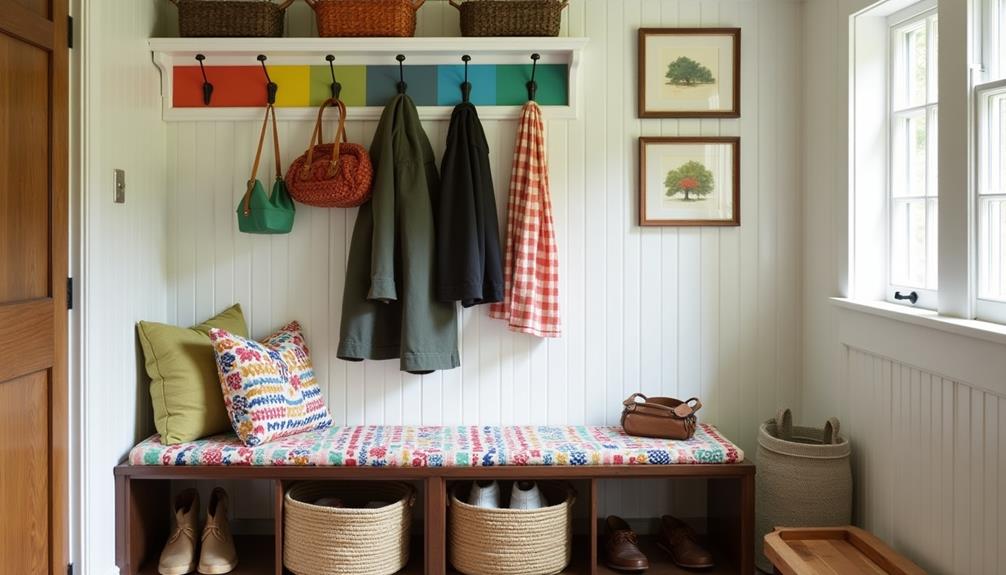
Everyone loves a space that reflects their personality, and your mudroom is no exception. To make it truly yours, start by choosing a color scheme that resonates with you. A fresh coat of paint can set the tone, while themed decor adds character. Consider incorporating wall art that showcases your interests or hobbies.
Don't forget to include personal touches like family photos that capture cherished moments. You can create a gallery wall or use a single large frame for a statement piece. Add unique sculptures or decorative items that reflect your style, making the space feel welcoming.
Seasonal accents can also bring life to your mudroom throughout the year. Swap out decor for different holidays or seasons to keep things fresh and exciting.
Finally, consider adding inspirational quotes that motivate you as you head out the door.
With these ideas, your mudroom won't only be functional but also a true reflection of you and your family. Personalizing your space makes it a joyful place to come home to, setting the perfect tone for your daily routine.
Maintain Regular Cleaning Routine
To keep your mudroom looking its best, you need a regular cleaning routine.
Start with a daily checklist to tackle the essentials and don't forget to schedule seasonal maintenance tasks.
Organizing your cleaning supplies will make it easier to stay on top of everything.
Daily Cleaning Checklist
Kickstart your daily cleaning routine by tackling the mudroom, a space that can quickly become cluttered and dirty.
To maintain a functional area, establish a cleaning schedule that incorporates simple tasks you can complete each day. Start by sweeping or vacuuming the floor to remove dirt and debris brought in from outside.
Next, wipe down surfaces with effective cleaning products to eliminate any stains or smudges.
Don't forget to check the shoe rack; a quick tidy-up can prevent clutter from building up.
Hang up jackets and bags to keep everything in its place, which also makes it easier to spot what you need on your way out.
Seasonal Maintenance Tasks
Seasonal maintenance tasks are essential for keeping your mudroom in top shape throughout the year. To stay on track, create seasonal checklists that outline specific tasks you need to tackle.
For instance, as winter approaches, check for any drafts around doors and windows, and ensure your heating system is ready. You'll want to store away summer gear and swap in winter essentials like boots and heavy coats.
In spring, focus on deep cleaning. Remove everything from the space, clean surfaces, and check for any wear and tear on your storage solutions.
Consider weather considerations, like mud and moisture, that come with spring showers. You may want to invest in a good mat that can handle wet shoes.
During summer, inspect your mudroom for signs of damage caused by humidity and heat. Make sure ventilation is adequate to prevent mold growth.
Finally, in the fall, prep for the coming cold months by checking that your mudroom is organized and clutter-free, making room for seasonal items.
Organizing Cleaning Supplies
A well-organized supply area is key to maintaining a regular cleaning routine in your mudroom. Start by designating a specific space, like a cabinet or shelf, for your cleaning products. This keeps everything in one place and easily accessible when you need it.
Next, take an inventory of your supplies. Check what you have, and discard any outdated or unused items. You want to ensure that you only keep essential cleaning products that you regularly use.
Consider grouping them by type—like sprays, wipes, and brushes—to streamline your cleaning process.
Use clear bins or baskets to store these items. Label each container to quickly identify what's inside. This way, you won't waste time searching for a specific product when you're ready to clean.

